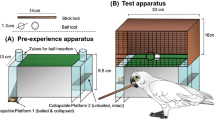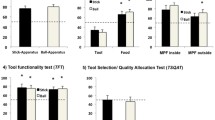Abstract
Nonhuman tool use is no longer questioned; the issues now are whether such use is mostly inflexible and innately specified or involves experience, innovation, adaptation, and cognitive planning, and how many species qualify. Habl and Auersperg (PLoS One, 12(11):e0186859, 2017) have shown that some Goffin’s cockatoos (Cacatua goffiniana) respond in novel ways to a tool-use task that nonhuman primates and young children find somewhat challenging.
Similar content being viewed by others
Once considered unique to humans, tool use has since been found in several avian species. The issues now are the extent to which this behavior is innately specified and rigid, versus innovative, flexible, and cognitively challenging, and in how many species such behavior can be observed. Although avian tool use is most commonly found in corvids, several intriguing forms of tool manufacture and use by Goffin’s cockatoos (Cacatua goffiniana) have been documented by Auersperg and colleagues (e.g., Auersperg, Borasinski, Laumer, & Kacelnik, 2016).
Recently, Habl and Auersperg (2017) tested these birds in a demanding experiment: The subjects had to match, orient, and insert one of several possible three-dimensional shapes (“keys”) into a specific frame (“lock”) to release a reward. Success required understanding an allocentric frame of reference: not, for example, simply orienting a limb to fit into a slot (egocentric orientation), but figuring out how to rotate a separate external object to match the orientation of another separate external object. A similar, somewhat simpler, task had been given to chimpanzees (Pan troglodytes), capuchin monkeys (Cebus paella), and young children (see Fragazsy, Kuroshima, & Stone, 2015). The children and nonhuman primates were given a specific shape and tested on how quickly they discovered how to orient and insert it into a given frame; the cockatoos were also required to choose the correct shape among several possibilities after being given a frame. The nonhuman primates found their task challenging, predominantly when the matches involved asymmetric items; children had to be about three years old to succeed on the most difficult matches. Some cockatoos succeeded on all matches, despite the increased level of difficulty in their task. Particularly interesting is that the birds sometimes gamed the system, finding simpler solutions to the insertion, and sometimes their accuracy decreased as tasks were presented repeatedly. Detailed examination of the results provides insight into these parrots’ abilities.
Initially, a subset of the subjects experienced related tasks as unstructured play: Several cockatoos were, for example, simultaneously given multiple shapes and multiple frames and left to explore. No bird made a significant number of appropriate insertions. Thus, unlike two- to three-year-old children, whose spontaneous play has been shown by several researchers to involve such combinatorial behavior, cockatoos were not inherently motivated to match the shapes to the frames. Given that no extrinsic rewards were forthcoming for any particular actions, and that multiple shapes and frames concurrently were available, the cockatoos were likely more interested in manipulating the individual shapes than in placing them in the frames. Human demonstration of the desired behavior increased the birds’ success, but never to a statistically significant level. Moreover, such preexposure to these shape–frame tasks did not give this subset an advantage in the actual experiment, which was organized somewhat differently.
In the subsequent formal experimental tasks, in each trial all 13 cockatoos viewed one of several possible frames (the “lock”) and a choice of several (depending on the task, either three or five) shapes (the “keys”). Here the birds first needed to use the lock’s shape to decide upon a choice of key and, technically, then orient it appropriately to allow insertion into the lock. Although the mean number of correct responses over all 13 birds was significant, only two birds actually succeeded initially when required to choose among triangle, square, and circle keys; similarly, only four birds succeeded on the first three sessions when presented with one of five locks and a choice of five circular keys distinguished by up to four attached stick projections; note that two stick orientations existed for a circle with two projections (90° and 180° apart). Nevertheless, the early success of some of the birds shows that the tasks are clearly within the purview of the species; moreover, the requirement of a correct key choice made these tasks more complex than those given to the children or nonhuman primates.
As was noted above, the cockatoos could game the system. To do so, the birds still chose the correct key (an achievement in and of itself), but they learned they didn’t need to orient it exactly; rather, they could slip it in with respect to a different, simpler axis (see the videos for Habl & Auersperg, 2017). Lacking the fine motor skills that come with an opposable thumb, cockatoos must use their beaks and tongues to manipulate objects; notably, orienting objects held in the beak using eyes whose binocular overlap is very likely less than that of humans is extremely challenging. [The binocular overlap of the sole parrot in which this has been studied, the Senegal (Poicephalus senegalus; Demery, Chappell, & Martin, 2011), is only ~30°.] That the cockatoos discovered how to achieve the desired result in a simpler manner says much for their flexibility and cognitive innovation. Given that neurobiologists have shown that those brain areas in parrots that correspond to the primate cerebral cortex are, as compared to those areas in other avian species, among the largest and also the densest with respect to neuronal packing, these findings are not necessarily surprising, but nonetheless they are noteworthy.
Occasionally, cockatoos’ accuracy decreased in later sessions. Here, previously successful subjects began to examine other affordances of the experimental system. Such “boredom” responses are not uncommon when highly intelligent parrots are asked to repeat a behavior already proven efficacious (e.g., see the data on keas,Nestor notabilis, from Gajdon, Amann, & Huber, 2011). Again, such actions attest to the intelligence of the various species, rather than detract from their performance.
In sum, Goffin’s cockatoos’ success on these shape-fitting tasks, even if it was limited to a subset of subjects and achieved by gaming the system, provides important data on flexibility and problem-solving, as well as much-needed comparisons to children’s and nonhuman primates’ tool use. Unlike children, cockatoos had no innate interest in the tasks, yet some succeeded. Like nonhuman primates, cockatoos were challenged by the more complex shapes, yet some birds devised novel, simpler solutions. Of interest will be comparative studies on both related cockatoo species and other purportedly intelligent birds, especially those not known for behavior patterns involving object manipulation. Also of importance will be determining the roles of binocular overlap, tongue strength, and beak form. How would cockatoos respond if the orientation match had to be exact? The scientific community looks forward to further research.
References
Auersperg, A. M. I., Borasinski, S., Laumer, I., & Kacelnik, K. (2016). Goffin’s cockatoos make the same tool type from different materials.Biology Letters, 12, 20160689.
Demery, Z. P., Chappell, J., & Martin, G. R. (2011). Vision, touch and object manipulation in Senegal parrots, Poicephalus senegalus. Proceedings of the Royal Society B, 278, 3687–3693.
Fragaszy, D. M., Kuroshima, H., & Stone, B. W. (2015). “Vision for action” in young children aligning multi-featured objects: Development and comparison with nonhuman primates. PLoS ONE,10, e0140033. https://doi.org/10.1371/journal.pone.0140033
Gajdon, G. K., Amann, L., & Huber, L. (2011). Keas rely on social information in a tool use task but abandon it in favor of overt exploration. Interaction Studies, 12, 304–323.
Habl, C., & Auersperg, A. M. I. (2017). The keybox: Shape-frame fitting during tool use in Goffin’s cockatoos (Cacatua goffiniana). PLoS ONE,12, e0186859. https://doi.org/10.1371/journal.pone.0186859
Author information
Authors and Affiliations
Corresponding author
Rights and permissions
About this article
Cite this article
Pepperberg, I.M. Tool use in Goffin’s cockatoos: Shape/frame matching. Learn Behav 47, 1–2 (2019). https://doi.org/10.3758/s13420-018-0317-2
Published:
Issue Date:
DOI: https://doi.org/10.3758/s13420-018-0317-2




